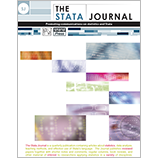Testing for zero inflation in count models: Bias correction for the Vuong test
Abstract. The proportion of zeros in event-count processes may be inflated by an
additional mechanism by which zeros are created. This has given rise to statistical
models that accommodate zero inflation; these are available in Stata through the
zip and zinb commands. The Vuong (1989, Econometrica 57: 307–333) test is
regularly used to determine whether estimating a zero-inflation component is appropriate
or whether a single-equation count model should be used. The use of the
Vuong test in this case is complicated by the fact that zero-inflated models involve
the estimation of several more parameters than the single-equation models. Although
Vuong (1989, Econometrica 57: 307–333) suggested corrections to the test
statistic to address the comparison of models with different numbers of parameters,
Stata does not implement any such correction. The result is that the Vuong test
used by Stata is biased toward supporting the model with a zero-inflation component,
even when no zero inflation exists in the generative process. We provide
new Stata commands for computing the Vuong statistic with corrections based on
the Akaike and Bayesian (Schwarz) information criteria. In an extensive Monte
Carlo study, we illustrate the bias inherent in using the uncorrected Vuong test,
and we examine the relative merits of the Akaike and Schwarz corrections. Then,
in an empirical example from international relations research, we show that errors
in selecting an event-count model can have clear implications for substantive
conclusions.
View all articles by these authors:
Bruce A. Desmarais, Jeffrey J. Harden
View all articles with these keywords:
zipcv, zinbcv, count models, Poisson, zero-inflated Poisson, negative binomial, zero-inflated negative binomial, Vuong test, AIC, BIC, zip, zinb
Download citation: BibTeX RIS
Download citation and abstract: BibTeX RIS
|
